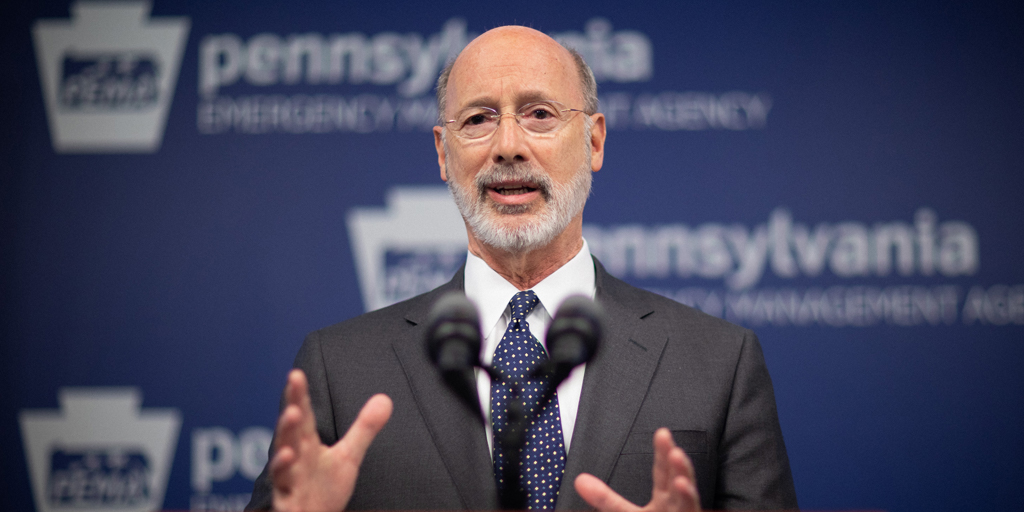Angela Couloumbis of Spotlight PA
Spotlight PA is an independent, nonpartisan newsroom powered by The Philadelphia Inquirer in partnership with the Pittsburgh Post-Gazette and PennLive/Patriot-News.
HARRISBURG — As coronavirus cases continue to climb in certain parts of the state, Gov. Tom Wolf on Wednesday announced tighter restrictions on bars, restaurants, and other businesses statewide, as well as new limits on indoor gatherings.
Wolf said the new order is necessary to prevent Pennsylvania from experiencing a devastating rise in cases that threatens to overwhelm hospitals, as is happening now in Southern states like Florida and Texas. These “targeted mitigation efforts,” he said, lean on knowledge about how the virus has spread indoors, and at places like bars and restaurants.
“When we hit our peak on April 9, we hit nearly 2,000 new cases that day,” Wolf said at an afternoon press briefing. “And what we’re seeing right now could soon be even worse than what we saw before.”
Under the order, restaurants and bars that serve food will only be allowed to seat people indoors at up to 25% of their capacity (currently, seating is allowed up to 50% capacity). Seating will only be allowed at tables, and patrons can only order alcohol with a meal.
Bars that don’t serve food can sell alcohol to-go, but cannot offer in-person service. Outdoor dining restrictions will not change.
Nightclubs must close, while indoor “gatherings and events” — such as in a concert hall, an individual movie theater, and even business meetings in rooms within a larger conference facility — will be limited to no more than 25 people. Outdoor events remain limited to 250 people.
Additionally, businesses will be required to have employees telework if possible. Gyms and fitness facilities will be allowed to remain open, with the current restrictions involving mask-wearing and social distancing remaining in place.
Businesses that do not follow the restrictions could be fined, closed, or subject to other penalties, the governor’s office said. Wolf did not spell out a plan to enforce the rules, though he said there are “legal consequences” for failing to abide by the measures.
Reaction to Wolf’s order, which is in place indefinitely, was swift and forceful.
“Reduction to 25% capacity is essentially the same as eliminating indoor dining entirely, and there is no scenario that restaurants can survive at that level of occupancy,” said John Longstreet, president and CEO of the Pennsylvania Restaurant and Lodging Association, which is instead advocating for shutting down problem establishments.
Chuck Moran, who heads the Pennsylvania Licensed Beverage and Tavern Association, called on the state to develop a bailout package for the industry.
“Without help, we will see more small-business restaurants and taverns not survive,” Moran said.
The rollbacks are the first the administration has announced since it began reopening counties in May. All counties currently are in the least restrictive “green” phase, though masks are now required for most people in public spaces.
Wolf, who had fielded fierce criticism from Republicans for imposing statewide restrictions rather than allowing counties to make their own public health decisions, just last month declared Pennsylvania’s response to the pandemic a success. He said his administration’s “phased, measured reopening plan” had helped it avoid the fate of other states, which were experiencing spikes in new cases as they reopened.
But in recent weeks, coronavirus cases have steadily risen in certain counties, most notably Philadelphia and Allegheny.
At Wednesday’s press conference, Wolf ticked off three reasons for the spikes: Some people are ignoring the state’s mask requirement, unknowingly contracting and spreading the virus; travel, including to heavily impacted states, has increased as people take summer vacations; and the “lack of a national coordination” plan, as he called it, which led some states early on to impose few restrictions, leading to alarming surges there now.
“We did everything we should have done,” Wolf said. “We were responsible. And yet we are paying a price right now.”
David Rubin, a pediatrician and director of PolicyLab at Children’s Hospital of Philadelphia, said at Wednesday’s news briefing that there is “extremely clear” evidence that the disease resurgence is quickly moving into the Northeast region of the U.S. He said the hospital’s virus tracker has shown “increased disease activity” in the New Jersey and Pennsylvania counties surrounding Philadelphia, and increased risk of transmission statewide.
“Simply stated, we are seeing now widespread community transmission throughout the Northeast area,” Rubin said. “It’s of sufficient concern now that if we do not act decisively in the next six weeks, we may not be in the favorable terrain we had hoped to be in … to assure the public that opening schools will be safe after Labor Day.”
Wolf, too, couched the new restrictions as a way to ensure that case counts decrease so that schools can reopen safely for in-person instruction.
“We need to nip this in the bud,” he said, “so that we have a fighting chance to get to a point where parents are going to feel comfortable and confident that they can send their children to school.”
At the peak of new cases in April, Pennsylvania confirmed 2,000 new virus cases in one day. By June, that had dropped to 300 or 400 new cases per day.
But cases have risen again, hitting just over 1,000 in a single day last week and 994 on Wednesday.



